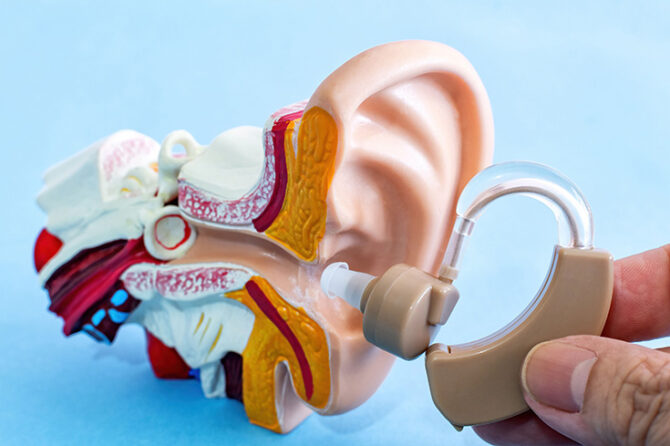
Summary: In the article “Revolutionizing SSNHL Diagnostics and Prognostics,” the authors introduce an innovative MR protocol specifically tailored for diagnosing Sudden Sensorineural Hearing Loss (SSNHL). Through extensive patient analysis, the study validates the MR’s capability to effectively discern between cochlear and retro-cochlear lesions. The research highlights the crucial role of the 3D-FLAIR sequence in detecting cochlear lesions and establishes a prognosis model that takes into account various factors like OAEs, treatment timing, and initial PTA. These advancements in the fields of audiology, neurology, and neuroscience signal a promising direction for improved diagnostics and patient-centric prognostic measures, though further expansive research is necessary.
Sudden Sensorineural Hearing Loss (SSNHL) presents a complex challenge in Otorhinolaryngology practice, necessitating advanced tools for diagnosis and prognosis. The article “Clinical Value of a Novel Magnetic Resonance Imaging Protocol and Prognostic Model Establishment for Sudden Sensorineural Hearing Loss: A Prospective Study” by Yanjun Wang, Yuancheng Wang, et al., published in Audiol Neurotol (2023), introduces a novel MR protocol to identify causes and prognostic indicators of unilateral SSNHL, bridging audiology with neurology and neuroscience.
SSNHL, a common acute symptom in otolaryngology, can lead to permanent hearing loss and reduced quality of life if untreated. Despite its increasing incidence, most cases remain idiopathic due to insufficient assessment. Standardized magnetic resonance (MR) of the inner ear, particularly 3D fluid-attenuated inversion recovery (FLAIR) MR imaging, has the potential to detect abnormalities, yet its clinical application is limited due to lack of standardization and validation.
The study involved comprehensive audiological evaluations and MR examinations using a 3.0 T scanner. An experienced radiologist assessed the MR images, with each sequence having specific diagnostic significance. The study focused on patients with unilateral SSNHL, examining the relationship between 3D-FLAIR findings, clinical features, and response to treatments. Statistical analysis sought to understand the influence of clinical and MR parameters on hearing recovery.

Of the 108 initial SSNHL patients, 101 were included in the study, with varying causes identified. The MR+ group, with detectable MR abnormalities, had worse initial hearing and more severe symptoms than the MR- group. Factors significantly associated with recovery included age, onset-to-examination periods, initial pure tone average (PTA), audiogram configurations, and positive MR findings. A two-step prognostic model was introduced, assessing overall recovery likelihood and chance of complete recovery, influenced by factors like DPOAE, TEOAE, treatment onset time, PTA, and MRI findings.
The study validated MR’s effectiveness in diagnosing SSNHL causes and identifying prognosis indicators. MR proved advantageous in distinguishing between cochlear and retro-cochlear lesions, with 30.1% of patients showing labyrinthine signal abnormalities, predominantly cochlear lesions. The severity of initial hearing loss correlated with positive 3D-FLAIR outcomes. The prognosis model assessed recovery chances, revealing that an initial PTA of 56 dB or less indicated better recovery odds. Early treatment, within 5 days of onset, improved prognosis, whereas age ≥50 years negatively impacted recovery. While 3D-FLAIR wasn’t a primary prognosis determinant, it revealed the extent of hearing loss and inner ear damage.
Yanjun Wang, Yuancheng Wang, and their team’s research highlights MR’s potential in SSNHL diagnostics and prognosis. Their MR protocol distinguishes between cochlear and retro-cochlear lesions and provides a comprehensive prognostic model. Factors like OAEs, treatment timing, and initial PTA, along with 3D-FLAIR findings, emphasize SSNHL’s complexity and the need for nuanced treatment approaches. This study marks a step forward in audiology, neurology, and neuroscience, pointing towards more precise diagnostics and patient-centric prognostics, though further expansive research is essential for robust validation.
Comment: This ground-breaking study by Yanjun Wang and Yuancheng Wang offers a transformative approach in SSNHL diagnosis and prognosis. Their innovative MR protocol and prognostic model not only enhance our understanding of the complexities of SSNHL but also pave the way for more precise, patient-focused treatments in audiology.
Reference / You can access the article at the following link:
Yanjun Wang, Yuancheng Wang, Zhongjiang Wang, Xiaohui Chen, Xiaoqiong Ding, Shenghong Ju; Clinical Value of a Novel Magnetic Resonance Imaging Protocol and Prognostic Model Establishment for Sudden Sensorineural Hearing Loss: A Prospective Study. Audiol Neurotol 3 April 2023; 28 (2): 138–150. https://doi.org/10.1159/000527738.
Leave a reply
















Prahlada Sir ,
Thanks for enlightening us on MRI (Magnetic Resonance Imaging) usage to detect SSNHL ( Sudden Sensori Neural Hearing Loss ), through expert treatise on same by Yanjun Wang & Yuancheng Wang et al, published in Audiol Neurotol ( 2023 ).
Some key aspects to consider while using MRI for SSNHL are :
* High resolution imaging ==> essentially detects any structural abnormalities or lesions in the auditory pathway, consisting of cochlea,vestibulocochlear nerve( cranial nerve '8' ) & brain stem.
* T1 weighted images ==> provide good anatomical details ;
* T2 weighted images ==> detects inflammation, edema or other abnormalities affecting inner ear.
* Gadolinium contrast enhancement, used intravenously ==> enhances visibility of certain stuctures, especially labrynthine related vascular abnormalities, occlusion or tumours affecting auditory pathway…..all causing SSNHL.
* Diffusion-weighted imaging (DWI) ==> measures water diffusibility within tissues & detects acute ischaemic strokes or lesions that may affect auditory pathway.
* Three dimensional (3D) imaging ==> detects high resolution images of inner ear structures.
Ultimately the choice of MRI protocols in detection & prognostication of SSNHL may vary, depending on the specific clinical circumstances, the suspected underlying causes & expertise of radiologist.
Reply